A warm hello to you!
I just completed a two-week Panchakarma treatment in Kerala, India, and I’m excited to take you along on my journey into the Ayurveda bubble, sharing my experiences during this transformative and rejuvenating time.
You’ll learn how such a treatment unfolds, my personal reasons for undertaking it and how I felt throughout the process. If you have any further questions that aren’t answered here, don*t hesitate to get in touch with me. I would be happy to receive an email from you and answer your questions!
- What is a Panchakarma treatment?
- Why do I undergo a treatment?
- Arrival in a tiny paradise
- Progress of a 2 week Panchakarma
- My experiences during the treatment
1. What is a Panchakarma treatment?
You might be wondering what exactly a Panchakarma treatment is. Let me briefly explain it so you can have a better understanding. If you like to know more about the basic principles of Ayurveda please read this article.
Panchakarma is a holistic Ayurvedic cleansing and detoxification treatment for minimum 14 days. It is considered the royal discipline of Ayurveda. Panchakarma means “five actions,” referring to the five different elimination procedures that can be applied during the treatment. The possible elimination procedures include vamana (therapeutic vomiting), virechana (therapeutic purging), two types of basti (enema), and nasya (nasal cleansing).
In Ayurvedic terms, elevated doshas are eliminated through these procedures. Depending on the imbalance, the elimination procedures and treatments are individually selected and administered. The elevated doshas are primarily loosened through internal and external oiling, brought back to their main site, and then eliminated from there. Here you can read more about the Ayurvedic principles.
The Panchakarma treatment can always be divided into three phases: preparation, elimination, and rejuvenation. What exactly happens in these phases, and which treatments, medications, and food the patient receives, is always determined individually during the initial consultation based on the complaint and existing illnesses.
A treatment can be done annually for prevention and maintaining health, or for acute diseases and complaints. The best time to undergo a Panchakarma is in spring or autumn. For chronic illnesses, it is also possible at any time.
Keep in mind: a Panchakarma treatment is not a walk in the park, not a wellness vacation. From an Ayurvedic perspective, diseases are addressed at their root and eliminated. This can be very uncomfortable. And of course, you shouldn’t expect to be cured after just one treatment. Depending on the severity of the illness, it may take longer and multiple treatments might be recommended. Some conditions may not be curable, but at least they can be alleviated. Especially the time after the treatment is very crucial for how well you will continue to feel. That’s when the real work begins: integrating it into your daily life.


2. Why do I undergo a treatment?
Through my Ayurveda training, I understand why it makes sense to undergo a Panchakarma treatment and how it works. I’ve had a long-standing desire to finally experience Panchakarma myself, rather than just learning about it or listening to others’ experiences.
Additionally, my health situation has been stagnant for a long time. Although I’ve managed to resolve some of my issues and feel much better than I did during my time as a special needs teacher, there are still some things I just haven’t been able to get under control. This includes waking up every morning with extremely puffy eyes, feeling tired and low on energy despite getting enough sleep. On top of that, my nose is almost always blocked and I frequently sneeze or have a constantly runny nose. It feels like being perpetually sick. I’m also often plagued by muscle tension in my hips and legs.
Of course, I’ve had these symptoms checked by doctors for quite some time. I have no allergies, my bloodwork is excellent. But conventional medicine hasn’t been able to offer a real solution, apart from suggesting that I use a cortisone nasal spray (and to keep using it indefinitely…). I just didn’t want to accept that! So, I’m putting all my hope into the Panchakarma treatment. Surely, this must be something Ayurveda can resolve, right?
Since I had planned to participate in a study trip to India with the Rosenberg Ayurveda Academy, it was clear to me: I have to stay longer in India and undergo treatment there. I want to experience Panchakarma first hand in its country of origin. After some research, comparing testimonials and prices, I finally decided on Poonthottam Ayurvedasram in Kerala, near Palakkad.
3. Arriving in a tiny paradise
After four weeks of educational and exciting time in India, it was finally time for the last part of my journey. In the afternoon in Coimbatore, I said goodbye to my partner, with whom I had spent the last two weeks traveling through Kerala and got into the taxi organized by the Poonthottam Ayurvedasram, which would take me to the Ayurveda bubble in 2.5 hours.
After a very pleasant drive (the night before in Coimbatore, we had experienced a one-hour ride of horror with a reckless taxi driver), I arrived in Kulakkad around 6 PM and was warmly welcomed and directly accompanied to my room. My room had a direct view of the pond, a wonderful green oasis surrounded by palm trees and banana plants. A beautiful sunset made the arrival absolutely perfect. The evening’s agenda was simple: settle in, have dinner, and relax. Everything else would follow the next morning.
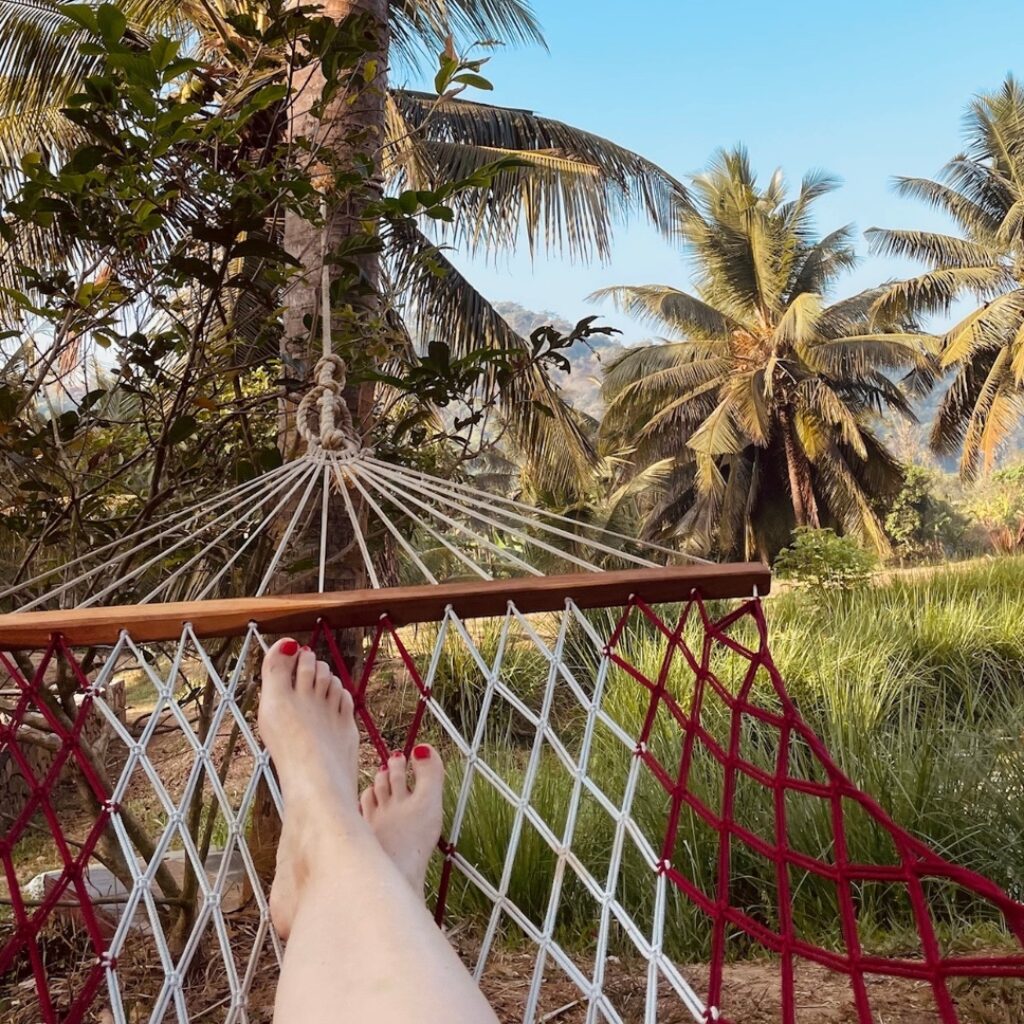

The first day started at 10 AM with the initial consultation with Dr. Ravi, a truly wonderful and kind-hearted person. I had tears in my eyes during our first meeting. He is the chief physician at Poonthottam. I was weighed, measured, and then asked to explain why I was there. Dr. Ravi then took my pulse, examined my tongue, and asked further questions about my life, work and symptoms. For him, it was quickly clear: my Vata is significantly elevated and due to the draining work as a special needs teacher, I have almost no ojas (life force) left and my dhatus (body tissues) are undernourished.
Hearing this hit me like a ton of bricks. I was aware that I hadn’t given myself enough time for true regeneration after my burnout; after all, life had to go on, and something new had to come. I had simply ignored that consciously slowing down and properly nourishing myself should have been the top priority. Instead, I completely overhauled my life. While this was also an important step, it would have surely been better to focus on my healing first and then deal with everything else.
But now, back to the diagnosis: The elevated Vata in my case has caused significant dryness in the head area, which the body has tried to compensate for by accumulating Kapha (mucus) in the head. The goal during the Panchakarma: eliminate and balance Vata, remove Kapha from the head, and build ojas. I was prescribed plenty of rest and was advised to interact as little as possible with other guests. This is often referred to as “therapeutic boredom,” directing all senses inward and giving the nervous system a chance to unwind. Afterward, my treatment plan was created, and appropriate medications were selected for me.
So, let’s get started! In the afternoon, the first treatment began right away.
4. Progress of a 2-week Panchakarma
A day during a Panchakarma treatment is very structured, with set times for meals, specific drinks and medications, as well as the therapeutic treatments. During my time at Poonthottam Ayurvedasram, the basic structure was as follows:
- 7 AM ginger tea with pippali and honey (improves digestion and eliminates Ama)
- 8.30 – 10 AM breakfast (iof course, I was half-starved and ready by 8.30)
- 11 AM coconut drink (a mix of fresh coconut meat and coconut water, cooling in Kerala’s heat)
- 12.30 – 2 PM lunch
- 4 PM fresh fruit and tea
- 5.15 PM Yoga
- 5.30 – 7 PM dinner

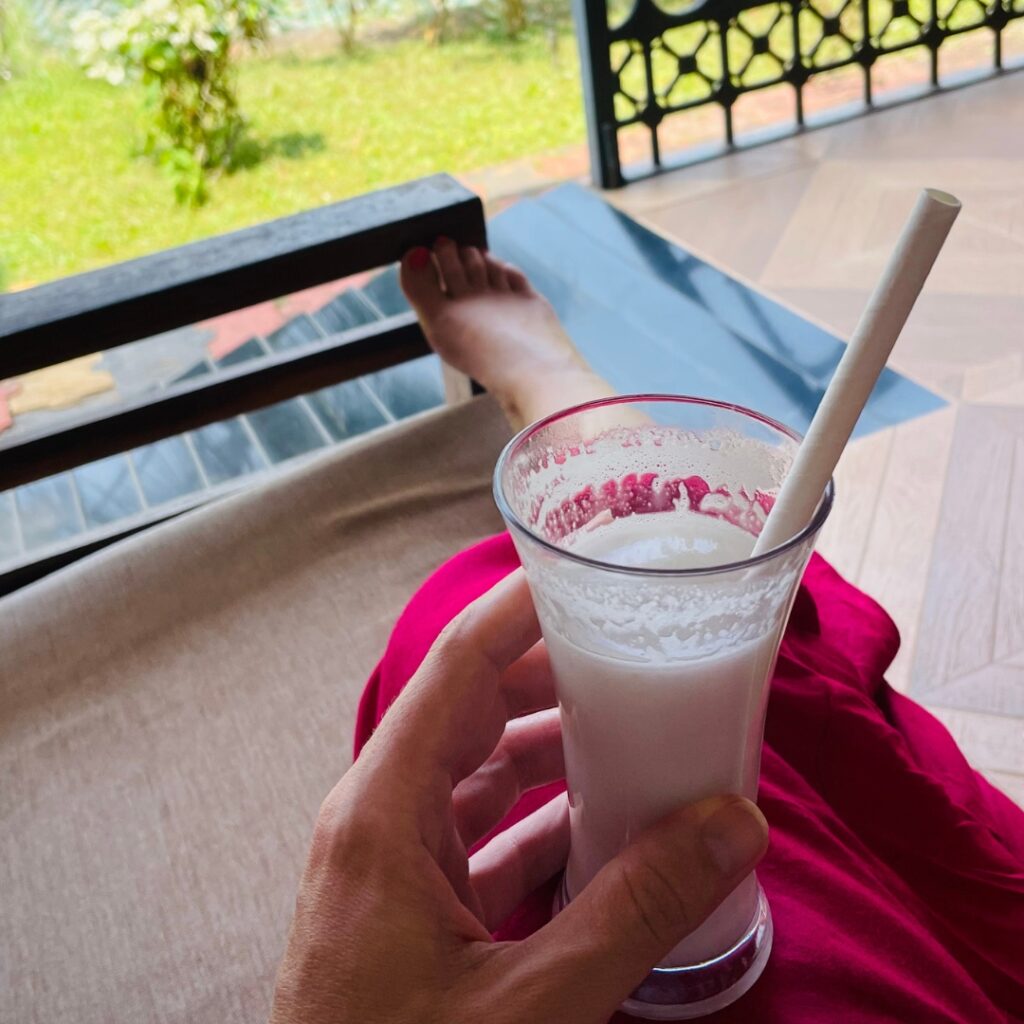
The treatments took place either in the morning or afternoon, which could vary from day to day. Most afternoons, Dr. Nihta would visit to check on me and assess the effectiveness of the treatment. If something wasn’t right, adjustments were made.
The medications were distributed daily by the nurses, so they could be taken before or after meals. In the afternoon, I also received warm milk with ghee, Ashwagandha, Bala, and Shatavari, called Kshiira Kashayam.
My treatment was focused on reducing Kapha in my head, eliminating excess Vata, and strengthening my body. Therefore, I didn’t go through a Snehapana phase (drinking ghee over several days) before the elimination process. I only had to take one teaspoon of medicated ghee before breakfast and dinner for the entire two weeks.
That’s what my personal treatment looked like:
Day 1-7
Every morning at 7:30 AM, I had Naysa. This involves first massaging the face with oil. Then, the face is steamed to loosen any stubborn mucus. Finally, four drops of medicated oil (Anu Thailam) are placed into each nostril. This was sometimes extremely uncomfortable and caused burning in my sinuses, ears, and head.
In the morning or afternoon, part 2 of the treatment followed, consisting of Abhyanga, Thailadhara, and Shirodhara. Abhyanga is the classic Ayurvedic full-body massage and takes about 45 minutes. The next treatment, Thailadhara, involves pouring warm oil continuously along the Marma points on the body for about 30 minutes. Then came Shirodhara, the forehead oil flow. Warm oil flows continuously onto the forehead through a special vessel hanging above the head. I was essentially drowned in oil for a week. You can imagine that I sometimes felt like a slippery fish—so much oil, from head to toe!
Day 8-10
These three days were my elimination days. I wasn’t allowed to eat breakfast, only drink tea in the morning. My treatment began at 7:30 AM with Abhyanga, followed by Svedana, and finally, the Basti. You already know what Abhyanga is. Svedana involves sitting in a beautiful steam box where only the head is exposed. This is followed by the elimination process through Basti, the enema. It is always customized individually. I received the Madhu Tailika Basti, which consists of oil, honey, an herbal decoction, and ghee. It has a calming effect on Vata and simultaneously eliminates Vata. Additionally, it is incredibly strengthening, a Rasayana, and according to Ayurveda, it acts even on the brain.
After the enema, I was given Kitchari for breakfast right away. I was instructed to eat immediately, as delaying it could cause stomach cramps. The rest of the day, I was allowed to enjoy normal meals again.
Day 11-15
After the elimination phase comes the rebuilding phase. My treatments during this time included Abhyanga, Shiroabhyanga, and Navaradhara. The amount of oil used was significantly reduced, so I was no longer “drowned” in oil. Shiroabhyanga is a massage focused on the head and shoulder area. Navaradhara was specifically developed at Poonthottam Ayurvedasram. Instead of being doused with oil, the treatment now involved a mixture of rice powder, herbs, and milk. This is meant to strengthen the bones and muscles. Additionally, this treatment has a wonderfully cooling effect, which was definitely welcome in the high temperatures. Navara, by the way, is a special type of rice that is only grown in Kerala. The grain is slightly rounder than usual and has a reddish tint. Very tasty!
And speaking of food: it was truly fantastic! Colorful, varied, filling, and yet typically easy to digest for Panchakarma. A dream!
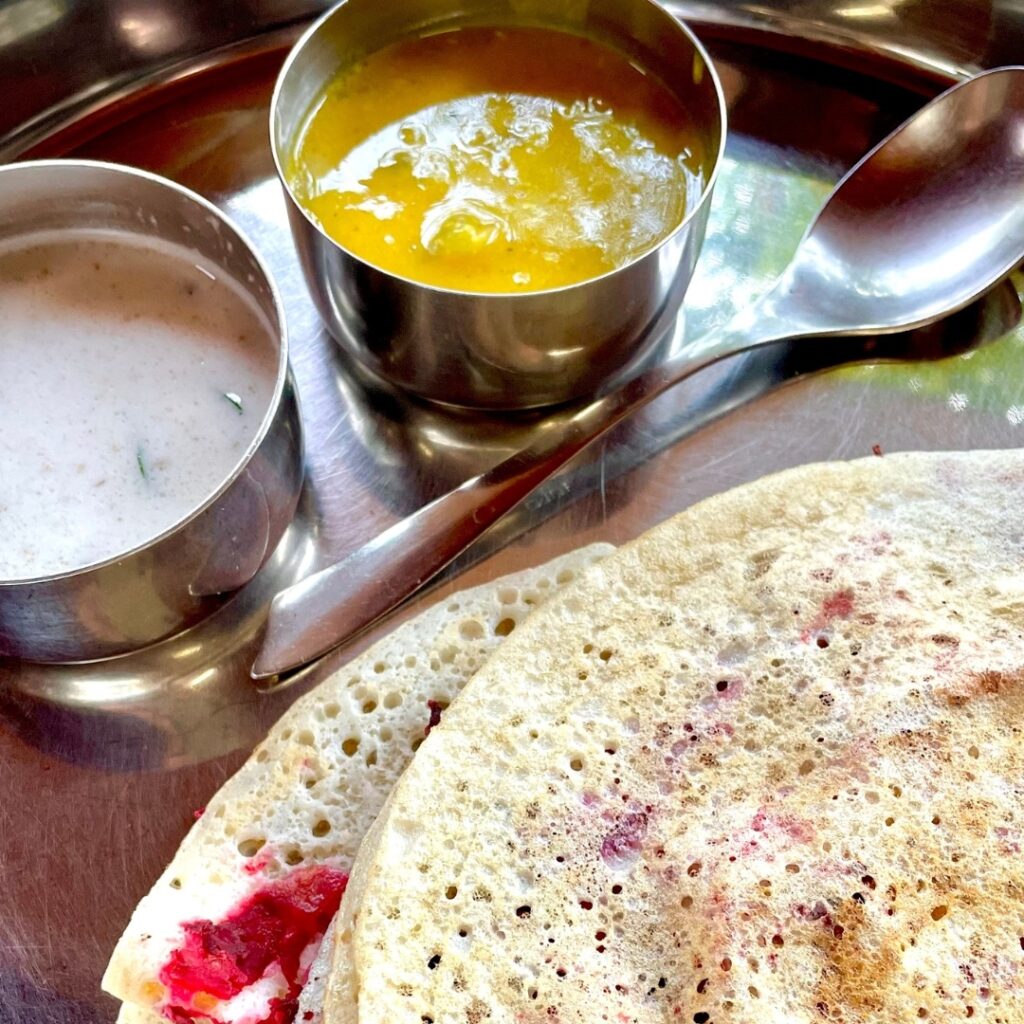

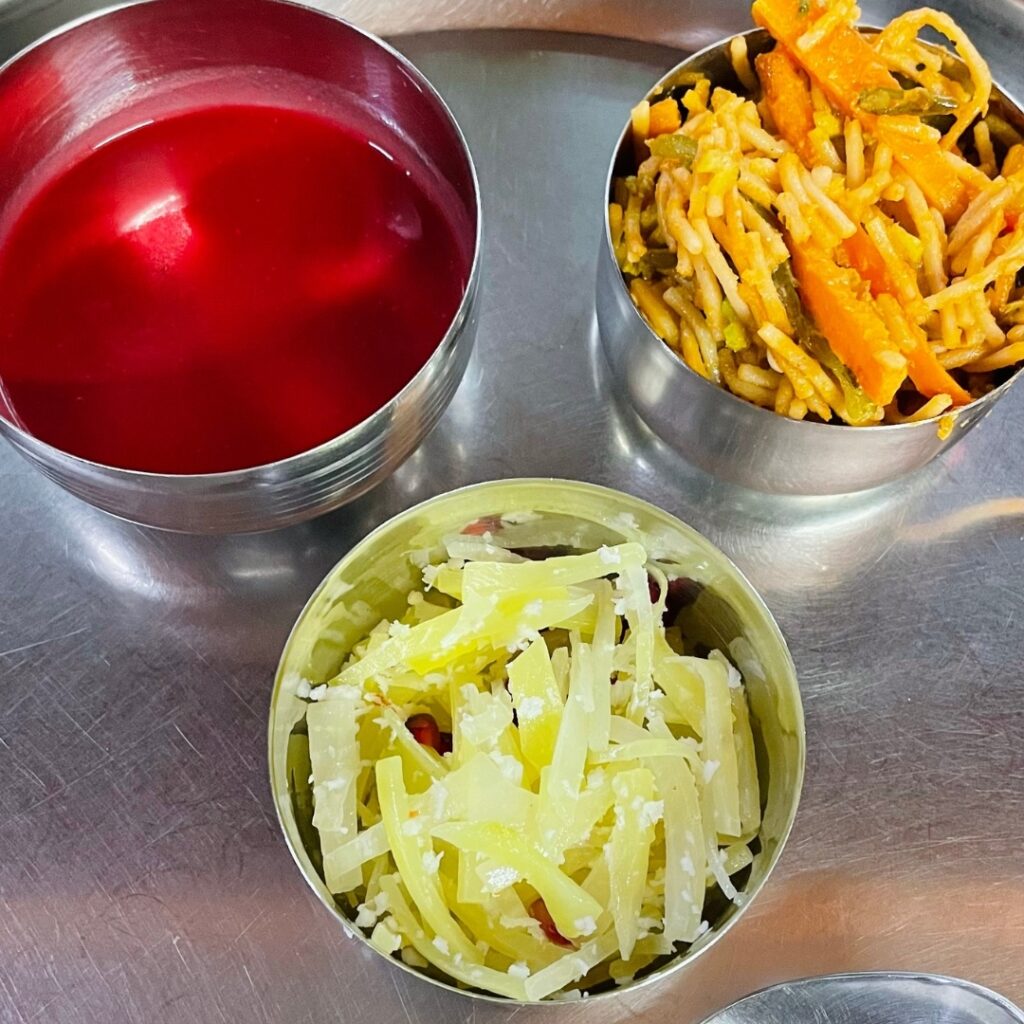
5. My experiences during the treatment
What did the Panchakarma treatment do for me? Do I feel better? Definitely. But the journey wasn’t entirely pleasant. In the first few days, I had severe headaches (even though I don’t drink coffee, so it wasn’t due to withdrawal), which finally subsided by day 4. The many oil treatments made me feel extremly heavy, and my thighs, particularly the hamstrings, became completely tense. I tried to participate in the yoga sessions, but it was more painful than relaxing. I had never experienced this before—I could hardly bend forward.
And the emotions! It was a wild rollercoaster ride. I was instructed to spend most of my time alone, and I managed to do so initially because I felt increasingly overwhelmed sitting at a table with others and eating together. The beauty of a Panchakarma treatment is that everyone understands this—everyone goes through challenging phases in their own way.
The peak of my emotional overwhelm came during the three days of Basti treatments. One day, I was asked to join the others for lunch because it was the last day for a fellow guest who was about to head home. Just the thought of sitting at a table with six people and engaging in lively conversations brought tears to my eyes. It was simply too much. Throughout the day, I had several moments where I suddenly burst into tears for no apparent reason. I believe that a lot of things were being released and coming to the surface.
I let the emotions flow through me. That’s the best thing you can do with feelings: acknowledge them, let them flow, and then let them go. No judgment, no overthinking. Just briefly stay in that uncomfortable moment and then release it. Afterward, I felt much lighter and, above all, calmer. And even the muscles in my legs finally loosened up and became much more flexible—hallelujah!

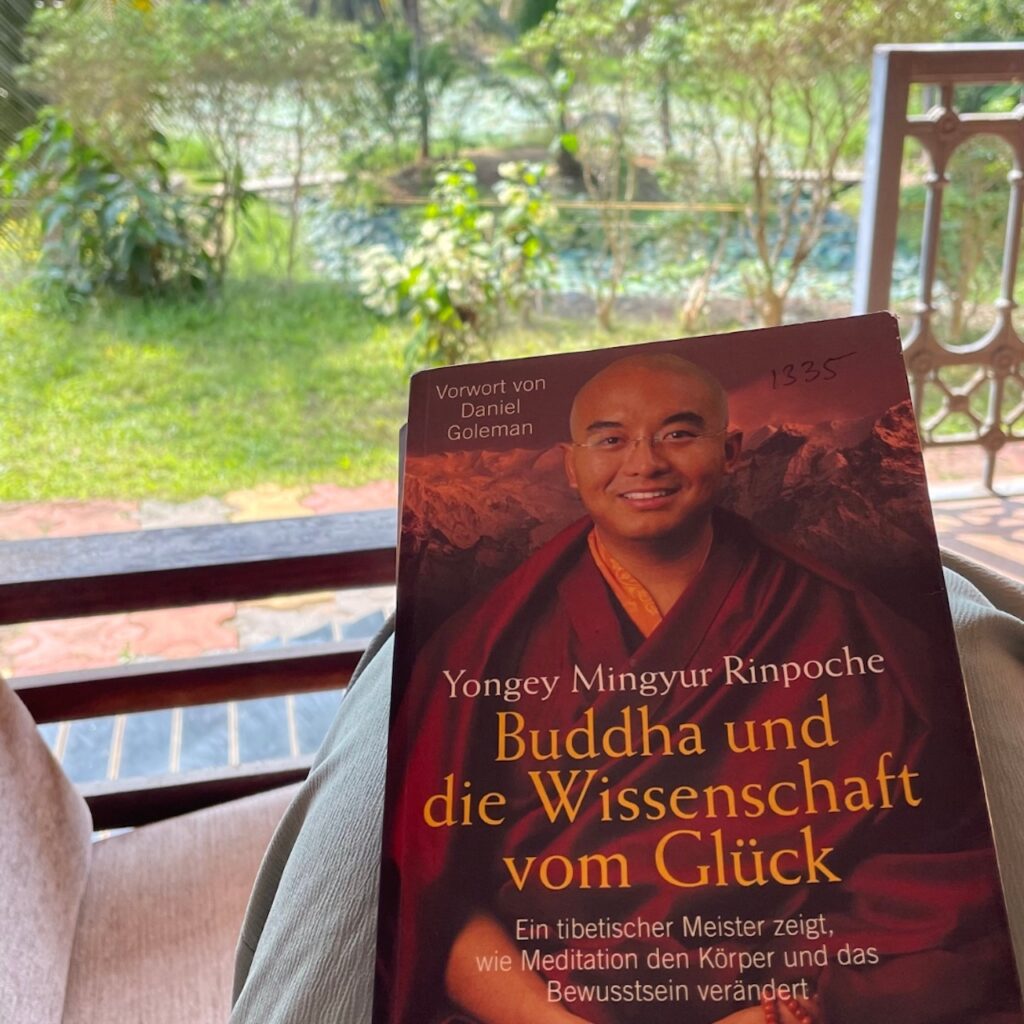

My daily highlight was mindfully observing nature. I often sat on my terrace or walked around the pond, admiring the surroundings. Throughout the day, so many beautiful birds gathered around the pond, and I was especially delighted by the kingfishers and peacocks. We rarely take the time to just sit outside and observe what’s happening around us. It’s so calming, and both the eyes and brain appreciate the screen-free time. I also spent a lot of time reading, which I absolutely love. I consciously used my phone very little, and that might be the most important experience: it feels so good!
But the best part is that my mind now feels lighter, freer. I’m sleeping much better and can really feel that I’m clearer and more alert. When I wake up in the morning now, my eyes aren’t swollen anymore. No more constant sneezing, and my nose is much clearer. It’s still not 100% gone, but I didn’t expect it to be—it will take some more time. The symptoms developed over many years, so of course, they won’t disappear completely in just two weeks; that much is clear. I’ll need to continue a milder form of Nasya at home and take medications for another three months.
I am incredibly grateful to have spent these two weeks at Poonthottam Ayurvedasram. The time there, with all the wonderful people and treatments, gave me new strength and freed me from old burdens. I feel so much more relaxed and grounded and will continue to take good care of my health and my needs—perhaps even a bit more than before. I’ll consciously take time for small breaks every day. And most importantly: I’ll pay special attention to my Agni! This certainly won’t be my last Panchakarma treatment.

